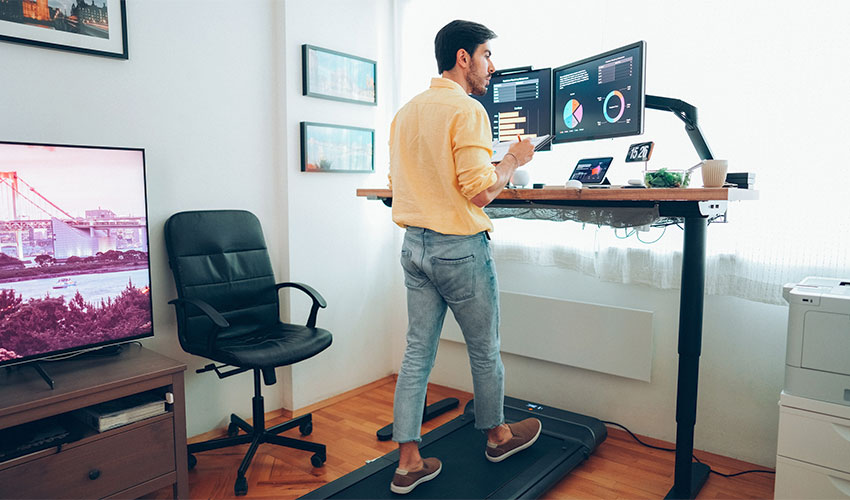An entire industry has evolved to provide antidotes to sedentary work habits with the promise of work and exercise at the same time. Many are allured by the standing desks, exercise balls, treadmill desks, and bicycle desks. In fact, companies and individuals globally spent an estimated $119 million in 2022 on treadmill desks alone, according to Imarc Research.1
As a business development manager, you may be receiving a multitude of requests for activity-inducing workstations. Here’s what you need to know before succumbing to the craze.
The benefits — and risks — of working out while working
Work-out-while-working devices promise to induce movement, burn calories, improve cardio-vascular health, and reduce the risk of chronic diseases associated with a sedentary lifestyle. But, treadmill, cycling, and elliptical desks come with a lot of hype and no small risk. “A distracted user could be conveyed right off the end of the treadmill, or trip and fall if side rails and auto-pause features are not in place,” says Thomas Neale, AVP Workers' Compensation Senior Specialist at Chubb Risk Engineering. There is also the question of distracting coworkers with the movement and noise of a large piece of equipment in the office. Equipment that encourages or requires constant movement, such as treadmill or cycling desks, may not be conducive to many types of work.
Compared to traditional desks, there is evidence they also reduce the ability to perform work-related tasks.2 Finding a comfortable, ergonomic position to work on such equipment can be a challenge as well. One study found that people working at a treadmill workstation experienced lower cognitive and fine motor skill performance, such as keyboarding and mouse pointing, compared to workers who were seated.3 So, while you think you are being healthy, your boss may be less than enthused about the work you are producing.
That is why some offices will offer a few active workstations in common areas for workers to try for short periods, rather than putting one under every desk. “Much of this equipment is great for what it was designed for: fitness and therapy. But no one needs to work their core for eight hours a day,” says Neale. There are safer, less expensive and healthier options to help workers move — and still work effectively.
What works — Sit, stand, and fidget
One option with documented benefits is an ergonomically designed adjustable desk that allows users to sit or stand, changing positions throughout the day. A recent meta study discovered that a wide range of interventions designed to reduce sitting time — including changes in workplace design to encourage movement such as treadmill desks and walking meetings — only the sit-and-stand desk was effective in reducing sitting time and increasing standing time.4

For those who want to spend some time at an active desk, whether cycling, treadmilling, working an under-desk elliptical machine or sitting on a rolling exercise ball–it’s best to start slow, experiment and stop immediately if there is any pain. And for those who prefer to sit in an office chair, there are other ways to increase activity. It turns out that fidgeting is good for us. There is evidence that even small movements can increase blood flow to restless arms and legs. One study found a 30% lower rate of all causes of mortality among people who fidget after adjusting for other factors, such as physical activity, smoking, diet and alcohol consumption.5
Whether sitting, standing, cycling or treadmilling, it’s still important to change positions often. Anyone who is stationary for more than a few minutes at a time should be encouraged to embrace their inner restlessness and stretch or squirm with abandon.6
Encourage workers to get up and move throughout the day
Everyone needs a break once in a while. Desk workers are commonly advised to follow the 20-20-20 rule: Every 20 minutes, take a 20-second break, look 20 feet away or close your eyes. That advice can give one’s eyes a rest, but it is not enough to offset some of the physiological problems that come from prolonged sitting.
One recent study discovered that five minutes of walking every half hour can alleviate some of the risk that comes from sitting for long stretches. Even an “activity snack” of one minute per hour reduced blood pressure for those who participated in the study.7 There is consistent evidence that moderate exercise — including doing the laundry or washing the dishes — can help moderate the inflammation that provokes chronic health problems. An analysis of almost 5000 Americans over several years found that people who broke up their sitting time with frequent short breaks experienced as much as 25% less inflammation than those who rarely rose from their chairs, even if they sat the same number of hours.8 One explanation is that any activity that wakes up muscles can help hold down levels of blood sugar and fat.
Helping workers rise from their chairs
Employers can help their employees by providing proper equipment as well as educating and encouraging healthy choices and work styles.
- Have an agreement with your remote workforce
This can include minimum standards for workspace, such as a properly sized desk and chair that come with a stipend to furnish a home office, suggests Neale. Perhaps more important from a movement point of view, establish acceptable work hours that leave time for physical activity.
- Provide equipment and benefits that encourage movement
Sit-and-stand desks, eating areas with space to stand, or a small break area with backless seating give workers space to move away from their desks and engage in light activity once in awhile. Enabling audio commands can free hands and help liberate employees from their chairs once in awhile. For companies that can afford it, bringing in a physical trainer once a week (or more) will help motivated employees increase their level of movement. (Holding fitness classes at or close by the workplace may have the added benefit of bringing reluctant hybrid workers back to the office once or twice a week.) There are relatively inexpensive small desk-based options as well, such as squeezable therapy balls for the hands or an ergonomically designed desk mat with a varied surface—anything that encourages alignment, strengthening and occasional movement combined with a bit of fun. Who can resist the fidgeting potential of a desk toy or tramping down on a squishy mat?
- Talk to an expert
A lot of companies will give stipends for equipment or offer fitness benefits with the best of intentions. But without some expert guidance, such benefits may be wasted money. “Entry-level, sit-and-stand desks may not be sized properly for every employee,” says Neale. The right workstation is only the beginning for an executive who spends a lot of time in client conference rooms or conducting business on a mobile phone. A comprehensive ergonomic assessment can suggest techniques no matter how or where people work. Many employees also could benefit from training to use the equipment and technology already available to them, such as hand-free options. There is no one size fits all approach.
Want to know more? Contact Chubb to learn how your company can assess different devices, techniques and training to help your employees work their best.







1 https://www.imarcgroup.com/under-desk-treadmill-market
2, 3 https://journals.humankinetics.com/view/journals/jpah/6/5/article-p617.xml
4 https://www.ncbi.nlm.nih.gov/pmc/articles/PMC6427179/
5,6,8 https://scholar.harvard.edu/exercised/daniellieberman
7 https://www.cnn.com/2023/01/12/health/sitting-prolonged-study-wellness/index.html
This document is advisory in nature and is offered as a resource to be used together with your professional insurance advisors in maintaining a loss prevention program. It is an overview only, and is not intended as a substitute for consultation with your insurance broker, or for legal, engineering or other professional advice.
Chubb is the marketing name used to refer to subsidiaries of Chubb Limited providing insurance and related services. For a list of these subsidiaries, please visit our website at www.chubb.com. Insurance provided by ACE American Insurance Company and its U.S. based Chubb underwriting company affiliates. All products may not be available in all states. This communication contains product summaries only. Coverage is subject to the language of the policies as actually issued. Surplus lines insurance sold only through licensed surplus lines producers. Chubb, 202 Hall's Mill Road, Whitehouse Station, NJ 08889-1600.












